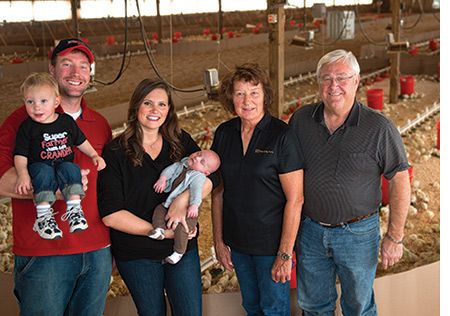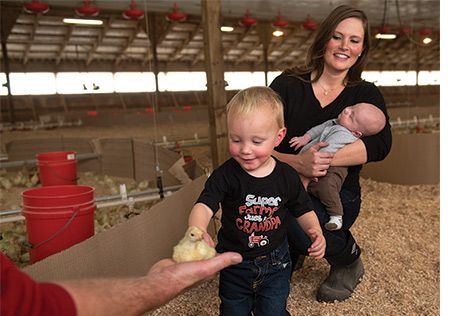Some people think about turkey every day
Author
Published
11/25/2014
When I think about Thanksgiving dinner, I picture turkey as the meal’s centerpiece. And while June is National Turkey Lover’s Month, most think of turkey right around Thanksgiving.
But turkey growers across Iowa and across the nation think about turkeys every day. That’s because these farmers are committed to growing healthy birds that go into the food chain. The whole turkeys we most associate with Thanksgiving aren’t grown in Iowa, according to Gretta Irwin, executive director of the Iowa Turkey Federation.
That turkey breast sandwich you order at Subway or the turkey tom sandwich at Jimmy Johns is another story. The deli meat on those sandwiches likely originated from an Iowa turkey farm. The turkeys Iowa farmers raise, mostly toms, go on to processing plants where they are processed into deli meat and sold through restaurants like Subway and Jimmy Johns. Turkey from Iowa farms is also found in Jimmy Dean breakfast sandwiches and turkey found in grocery stores under other labels.
 To learn more about Iowa’s turkey farms, I took an “agventure” to Don and Pat Daufeldt’s turkey farm in West Liberty. The couple is just one of more than 130 turkey growers in the state. The Daufeldts explained to me the care that is given to their poults (baby turkeys) after they arrive on their farm weighing just 4 grams each. The couple, along with their son, Brad, grow the birds to approximately 40-43 pounds each before they are sent to West Liberty Foods to be processed.
To learn more about Iowa’s turkey farms, I took an “agventure” to Don and Pat Daufeldt’s turkey farm in West Liberty. The couple is just one of more than 130 turkey growers in the state. The Daufeldts explained to me the care that is given to their poults (baby turkeys) after they arrive on their farm weighing just 4 grams each. The couple, along with their son, Brad, grow the birds to approximately 40-43 pounds each before they are sent to West Liberty Foods to be processed.
Though the family uses technology to control the environment inside of their barns, technology doesn’t replace frequent visits inside of the barns. The 19,500 poults the family received from the hatchery a few weeks ago require extra care. As I entered the poult barn with our photographer, Gary, and the family, we were instructed to wear plastic liners over our shoes and then dip our lined feet in a solvent that sterilized our liners. This, they explained, is one of the measures they use to keep the poults healthy and keep any undiagnosed diseases out of the barns. The barn was noticeably warm, too warm to wear our coats and mittens, even on a chilly Iowa day.
 The family explained that, like a baby, poults need to be kept warm. As the poults grow they are moved into different barns on the farm. The temperatures inside of the barns are regulated to a lower temperature as the turkeys grow; bigger birds create their own heat, they explained.
The family explained that, like a baby, poults need to be kept warm. As the poults grow they are moved into different barns on the farm. The temperatures inside of the barns are regulated to a lower temperature as the turkeys grow; bigger birds create their own heat, they explained.
We shed our plastic liners and made our way to the last of the three grower barns on the farm, the finishing barn. Here, turkeys are fed and watered until it’s time for them to be loaded onto trucks and sent to the processor. Whether in the poult barn, the intermediate barn or the finishing barn, the family explained that regular barn walk-throughs are an essential element of their daily chores.
This Thanksgiving, I’m grateful for the Daufeldt family for the opportunity to learn more about raising turkeys and the great care they take to raise safe and wholesome food. As I eat dinner for Thanksgiving dinner, I’ll think of the growers who raise turkeys that are sold as whole birds. But every day of the year, I’m thankful for all turkey growers and farmers who raise food for any meal.
Happy Thanksgiving!
By Bethany Baratta. Bethany is Iowa Farm Bureau's Commodities Writer.
But turkey growers across Iowa and across the nation think about turkeys every day. That’s because these farmers are committed to growing healthy birds that go into the food chain. The whole turkeys we most associate with Thanksgiving aren’t grown in Iowa, according to Gretta Irwin, executive director of the Iowa Turkey Federation.
That turkey breast sandwich you order at Subway or the turkey tom sandwich at Jimmy Johns is another story. The deli meat on those sandwiches likely originated from an Iowa turkey farm. The turkeys Iowa farmers raise, mostly toms, go on to processing plants where they are processed into deli meat and sold through restaurants like Subway and Jimmy Johns. Turkey from Iowa farms is also found in Jimmy Dean breakfast sandwiches and turkey found in grocery stores under other labels.
 To learn more about Iowa’s turkey farms, I took an “agventure” to Don and Pat Daufeldt’s turkey farm in West Liberty. The couple is just one of more than 130 turkey growers in the state. The Daufeldts explained to me the care that is given to their poults (baby turkeys) after they arrive on their farm weighing just 4 grams each. The couple, along with their son, Brad, grow the birds to approximately 40-43 pounds each before they are sent to West Liberty Foods to be processed.
To learn more about Iowa’s turkey farms, I took an “agventure” to Don and Pat Daufeldt’s turkey farm in West Liberty. The couple is just one of more than 130 turkey growers in the state. The Daufeldts explained to me the care that is given to their poults (baby turkeys) after they arrive on their farm weighing just 4 grams each. The couple, along with their son, Brad, grow the birds to approximately 40-43 pounds each before they are sent to West Liberty Foods to be processed.
Though the family uses technology to control the environment inside of their barns, technology doesn’t replace frequent visits inside of the barns. The 19,500 poults the family received from the hatchery a few weeks ago require extra care. As I entered the poult barn with our photographer, Gary, and the family, we were instructed to wear plastic liners over our shoes and then dip our lined feet in a solvent that sterilized our liners. This, they explained, is one of the measures they use to keep the poults healthy and keep any undiagnosed diseases out of the barns. The barn was noticeably warm, too warm to wear our coats and mittens, even on a chilly Iowa day.
 The family explained that, like a baby, poults need to be kept warm. As the poults grow they are moved into different barns on the farm. The temperatures inside of the barns are regulated to a lower temperature as the turkeys grow; bigger birds create their own heat, they explained.
The family explained that, like a baby, poults need to be kept warm. As the poults grow they are moved into different barns on the farm. The temperatures inside of the barns are regulated to a lower temperature as the turkeys grow; bigger birds create their own heat, they explained.
We shed our plastic liners and made our way to the last of the three grower barns on the farm, the finishing barn. Here, turkeys are fed and watered until it’s time for them to be loaded onto trucks and sent to the processor. Whether in the poult barn, the intermediate barn or the finishing barn, the family explained that regular barn walk-throughs are an essential element of their daily chores.
This Thanksgiving, I’m grateful for the Daufeldt family for the opportunity to learn more about raising turkeys and the great care they take to raise safe and wholesome food. As I eat dinner for Thanksgiving dinner, I’ll think of the growers who raise turkeys that are sold as whole birds. But every day of the year, I’m thankful for all turkey growers and farmers who raise food for any meal.
Happy Thanksgiving!
By Bethany Baratta. Bethany is Iowa Farm Bureau's Commodities Writer.